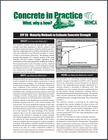Introduction to Concrete Maturity Methods
"Concrete maturity method" refers to a method of estimating the strength of in-place concrete using a calculated "maturity" index that is based on the time-temperature history of the in-place concrete. By generating a calibration curve for the particular mix design one can convert the measured maturity index to an estimated in-place concrete strength in real-time. The practice essentially replaces field cured test specimens, with a more convenient, and typically more accurate method of determining concrete strength. ASTM C1074 is typically used as a standard practice.
Since concrete strength can be estimated continuously using the maturity method, the maturity method is particularly useful when estimating the in-place strength of concrete prior to performing critical operations such as:
- Removal of formwork
- Removal of reshoring
- Post-tensioning
- Termination of cold weather protection
- Opening roadways to traffic
How to Use the Maturity Method
The steps to using the maturity method are as follows:
Note that there is no perfect method of determining the actual in-place strength of concrete, including (and perhaps especially) field-cured test specimens. Every method of estimating strength has its own set of limitations and tradeoffs. Several benefits and limitations of the maturity method are as follows:
- Cast Specimens (At Lab or job site): Cast a set of test specimens using the selected mix design. Typically a set of 17 cylinders are used. 2 for sensors + 15 for destructive testing.
- Cure Specimens (At Lab): Standard cure the test specimens to determine the potential strength of the mix design.
- Test (At Lab): Periodically (e.g. 1, 3, 7, 14, and 28 days) break test specimens and average in sets of 3, and record the corresponding maturity reading at the time at which the specimens are destructively tested.
- Generate Calibration Curve (At Lab): Generate a graph of strength (e.g. PSI) versus maturity (e.g. C-Hrs). This is the calibration curve, or strength-maturity relationship, for the mix design.
- Place Sensors (At job site): Place sensors in the in-place concrete at critical locations. These locations are typically chosen to be the locations where the concrete is weakest (e.g. coldest or last to be placed) and locations where strength is the most critical.
- Pour (At job site): Pour the concrete placement and make a set of validation test specimens that are to be standard cured to validate the consistency of the concrete. Place a maturity sensor in one of the specimens and use it to track the maturity of the test specimens themselves. These are to be used in the validation step below.
- Measure Maturity (At job site): Allow the sensors to accumulate time-temperature data and report the corresponding maturity reading.
- Convert to strength (At job site): Use the calibration curve to convert the maturity reading to an estimated strength of the in-place concrete. Repeat steps 7 and 8 anytime a strength estimate is desired.
- Validate (At Lab): Once the maturity method indicates that the target strength has been reached in the placement, break a set of standard cured test specimens and verify that the strength of the test specimens matches the calibration curve. This ensures that the in-place concrete is represented by the calibration curve as well. Note that the maturity of the placement should differ from the maturity of the test specimens because of the difference in temperature histories. What is important is that the validation breaks match the calibration curve to assure continuous potential strength agreement with the calibration curve batch-to-batch and over time.
Note that there is no perfect method of determining the actual in-place strength of concrete, including (and perhaps especially) field-cured test specimens. Every method of estimating strength has its own set of limitations and tradeoffs. Several benefits and limitations of the maturity method are as follows:
Limitations of Concrete Maturity Methods
- The in-place concrete moisture must be maintained to permit proper cement hydration.
- Mitigation: Protection from moisture loss is always important to assure a high-quality concrete placement.
- The maturity method does not account for all effects of early-age concrete temperature on long-term strength.
- Mitigation: Maturity methods are typically used for early-age concrete strength
- Maturity strength readings can be inaccurate if the concrete quality is not consistent (e.g. batching errors)
- Mitigation: Critical strength indications should be "backed up" by a secondary testing method to be sure the potential strength of placed concrete matches the calibration. This process is often referred to as the "validation" step which should be conducted prior to executing critical operations.
Benefits of Concrete Maturity Methods
- Concrete strength can be estimated continuously without breaking test specimens or running out of test specimens.
- Maturity typically provides a more accurate estimate of concrete strength than field-cured test specimens because it accounts for the actual temperature history of the in-place concrete
- Concrete operations can often be accelerated by having accurate, in-place concrete strength readings which are often much higher than the strength of companion test specimens at early ages due to higher in-place temperatures.
- The safety of critical operations can be improved, particularly in cold weather when strength gain is retarded by low concrete placement temperatures often resulting in lower placement strength when compared to its companion test specimens.
- Strength estimations may be extrapolated to estimate when, in the future, prescribed strength will be attained.
- Temperature history plots can often identify concrete quality issues early by identifying differences in early-age temperature profiles.
- Temperature minimums, maximums, and differences can be simultaneously determined by the strategic placement of maturity data loggers.
RESOURCES



